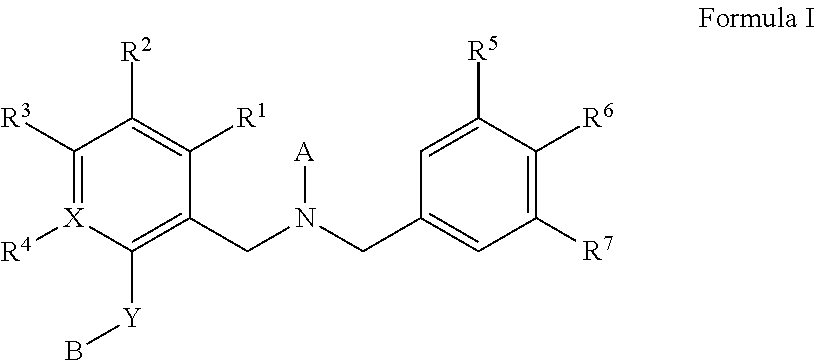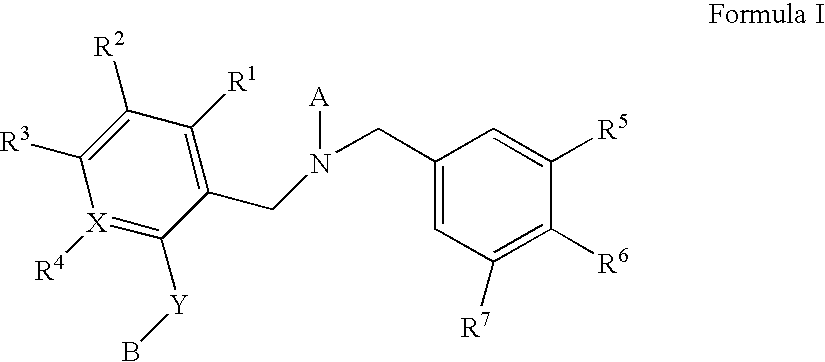Dibenzyl amine compounds and derivatives
a technology of dibenzyl amine and amine, which is applied in the direction of biocide, drug composition, metabolic disorder, etc., can solve the problems of reducing compliance, no wholly satisfactory hdl-elevating therapy is on the market today, and negatively correlated with the risk of cardiovascular diseas
- Summary
- Abstract
- Description
- Claims
- Application Information
AI Technical Summary
Benefits of technology
Problems solved by technology
Method used
Image
Examples
preparation 1
2-Bromo-5-(trifluoromethyl)benzoic acid
[0306]
[0307]To a solution of n-BuLi (26.7 mL of 2.5M solution in tetrahydrofuran (THF), 66.7 mmol) in THF (130 mL) at −78° C. was added 2,2,6,6-tetramethylpiperidine (22.5 mL, 133.4 mmol). The mixture was stirred at −78° C. for 30 minutes and then carefully lowered to −100° C. using liquid nitrogen. Neat 1-bromo-4-(trifluoromethyl)benzene (15 g, 66.7 mmol) was added. The mixture was kept at −100° C. for 6 hours and poured onto freshly crushed dry ice. The resulting mixture was stirred at room temperature for 16 hours. The residue solvent was removed by evaporation. Water (150 mL) was added and the mixture was extracted with diethyl ether (3×50 mL). The aqueous layer was acidified using concentrated hydrochloric acid (HCl), extracted with methylene chloride (3×50 mL). The combined organic layers were washed with saturated sodium chloride (NaCl) (75 ml), dried with magnesium sulfate (MgSO4), filtered and concentrated to yield the title compound a...
preparation 2
(2-Bromo-5-(trifluoromethyl)phenyl)methanol
[0308]
[0309]To an ice-cooled solution of 2-bromo-5-(trifluoromethyl)benzoic acid (5.16 g, 19 mmol) in THF (50 mL) was added borane-tetrahydrofuran complex (70 mL of 1M solution in THF, 70 mmol). The resulting mixture was stirred at room temperature for 16 hours. The reaction mixture was quenched with methanol. Solvent was removed. The residue was partitioned between ethyl acetate (3×40 mL) and 1M sodium bicarbonate (50 mL). The combined organic layers were washed with saturated NaCl (50 mL), dried (MgSO4) and concentrated to yield the title compound as an oil (4.85 g). 1H NMR (400 MHz, CDCl3) δ 4.8 (s, 2 H) 7.5 (m, 1 H) 7.7 (d, J=8.2 Hz, 1 H) 7.8 (d, J=1.6 Hz, 1 H).
preparation 3
1-Bromo-2-(bromomethyl)-4-(trifluoromethyl)benzene
[0310]
[0311]To a solution of (2-bromo-5-(trifluoromethyl)phenyl)methanol (4.7 g, 18 mmol) in methylene chloride (50 mL) at −10° C. was added carbon tetrabromide (CBr4) (7.17 g, 21.6 mmol). The resulting mixture was stirred at −10° C. for 15 minutes. Triphenylphosphine (5.61 g, 21.4 mmol) was then slowly added portion-wise. This mixture was stirred at room temperature for 16 hours. The mixture was partitioned between saturated ammonium chloride (NH4Cl) (50 ml) and methylene chloride (2×50 mL). The combined organic layers were washed with saturated NaCl (50 mL), dried (MgSO4) and concentrated. The residue was purified by flash chromatography (silica gel) (eluted with 3:1 hexanes-ethyl acetate) to yield the title compound as a white solid (4.01 g), 1H NMR (400 MHz, CDCl3) δ4.6 (s, 2 H) 7.5 (dd, J=8.3, 1.6 Hz, 1 H) 7.8 (m, 2 H).
PUM
| Property | Measurement | Unit |
|---|---|---|
| temperature | aaaaa | aaaaa |
| temperature | aaaaa | aaaaa |
| temperature | aaaaa | aaaaa |
Abstract
Description
Claims
Application Information
 Login to View More
Login to View More - R&D
- Intellectual Property
- Life Sciences
- Materials
- Tech Scout
- Unparalleled Data Quality
- Higher Quality Content
- 60% Fewer Hallucinations
Browse by: Latest US Patents, China's latest patents, Technical Efficacy Thesaurus, Application Domain, Technology Topic, Popular Technical Reports.
© 2025 PatSnap. All rights reserved.Legal|Privacy policy|Modern Slavery Act Transparency Statement|Sitemap|About US| Contact US: help@patsnap.com



